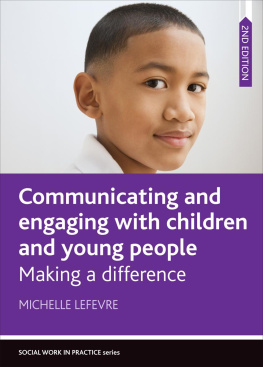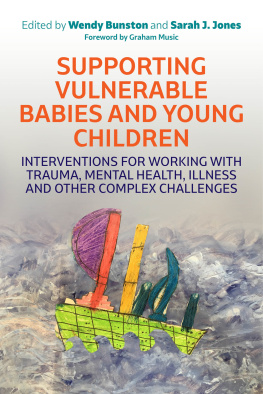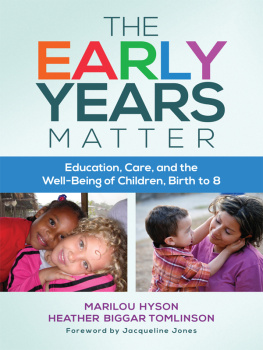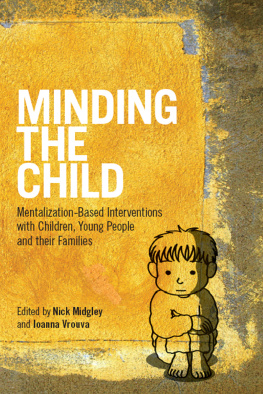Working with Children, Young People and Families
Working with Children, Young People and Families
Edited by
Graham Brotherton, Helen Davies and Gill McGillivray
Graham Brotherton 2010
Graham Brotherton and Gill McGillivray 2010
Hilary Dunphy and Terry Potter 2010
Graham Brotherton and Terry Potter 2010
John Ryan and Stephen Griffin 2010
Mark Cronin and Claire Smith 2010
Stan Tucker and Dave Trotman 2010
Roger Willoughby 2010
Claire Smith 2010
Gill McGillivray and Helen Davies 2010
Apart from any fair dealing for the purposes of research or private study, or criticism or review, as permitted under the Copyright, Designs and Patents Act, 1988, this publication may be reproduced, stored or transmitted in any form, or by any means, only with the prior permission in writing of the publishers, or in the case of reprographic reproduction, in accordance with the terms of licences issued by the Copyright Licensing Agency. Enquiries concerning reproduction outside those terms should be sent to the publishers.
SAGE Publications Ltd
1 Olivers Yard
55 City Road
London EC1Y 1SP
SAGE Publications Inc.
2455 Teller Road
Thousand Oaks, California 91320
SAGE Publications India Pvt Ltd
B 1/I 1 Mohan Cooperative Industrial Area
Mathura Road
New Delhi 110 044
SAGE Publications Asia-Pacific Pte Ltd
33 Pekin Street #02-01
Far East Square
Singapore 048763
Library of Congress Control Number: 2009943265
British Library Cataloguing in Publication data
A catalogue record for this book is available from the British Library
ISBN 978-1-84860-988-4
ISBN 978-1-84860-989-1 (pbk)
Typeset by C&M Digitals (P) Ltd, India, Chennai
Printed by CPI Antony Rowe, Chippenham, Wiltshire
Printed on paper from sustainable resources
To Dennis Brotherton (19272009)
For whom family was at the heart of everything.
Contents
1 Working with children, young people and families the policy context
Graham Brotherton
2 Changing childhoods, changing families
Graham Brotherton and Gill McGillivray
3 Working with parents
Graham Brotherton
4 The meaning of poverty: issues and policy development
Hilary Dunphy and Terry Potter
5 Children and young peoples health and well-being
Graham Brotherton and Terry Potter
6 Listening to childrens voices in educational settings
John Ryan and Stephen Griffin
7 From safeguarding to Safeguarding
Mark Cronin and Claire Smith
8 Interpreting risk: factors, fears and judgement
Stan Tucker and Dave Trotman
9 Situating child development
Roger Willoughby
10 Research with children, young people and families
Claire Smith
11 Developing yourself as a practitioner
Gill McGillivray and Helen Davies
12 Where are we going?
Graham Brotherton and Gill McGillivray
Working with children, young people
and families the policy context
Graham Brotherton
The aims of this chapter are to:
- Consider what we mean by policy in the context of children, young people and families and how this is shaped by government
- Consider how policy has evolved in recent years
- Explore the implications of current policy for those working with children, young people and families.
Anyone working with children young people and families cannot escape the significance of policy any workplace will have policies on a wide range of issues, for example on health and safety, safeguarding children and young people or equal opportunities. Policies exist at the local level as described here, but also at a national level, for example the broad sweep of policy ideas and issues which comprise Every Child Matters or Youth Matters. The local policies which govern dayto-day practice are a reflection of the concerns and priorities of national policy.
Policy around children, young people and families is therefore an area of social policy which can be described as the study of the way in which governments seek to influence social life. In this sense anyone working in this area can be said to be working in a political arena. It is therefore one of the central arguments of both this chapter and the book more generally that to understand the role of a practitioner working with children, young people and families, we need to understand the political context in which it takes place. In order to understand the way in which policy is created we need to look briefly at how government operates in the United Kingdom but with specific reference to England.
The structure of government in the
United Kingdom
One of the key features of the UK government, particularly in England, is that it is very centralised, even allowing for the recent impact of devolution (see later section in this chapter). This means that the government in general and the Prime Minister in particular has considerable power and the ability to exert considerable influence on policy. There are a number of overlapping reasons for this. In part this stems from the way in which the government is elected. The first past the post system in which Members of Parliament (MPs) are elected on the basis of who gets the greatest number of votes in a geographical constituency means that effectively government will almost always come from one of two parties; Labour or Conservative. This gives the leaders of these two parties considerable power within the party, as, effectively, political careers are dependent upon being successful within party hierarchies. This is reinforced especially in government by the fact that the Leader/Prime Minister (with close colleagues/advisers) has considerable power of patronage, that is the ability to appoint people to positions both within government and in government agencies (see below).
Governments of all political persuasions have been accused of appointing people to significant roles in agencies whose views support theirs, though in the last few years there has been a move to a more open selection process, through advertising for suitable applicants.
Activity: Government Agencies
This is a term used to refer to a range of organisations that are linked to government (often by funding) but are not technically part of government. Perhaps the most important for those working with children, young people and families is Ofsted which despite officially being called the Office for Standards in Education actually regulates not just education but also social care and related services for children and young people.
Whilst you may already have a basic understanding, find out more about the role of Ofsted, for example:
- How does it regulate settings working with children and young people?
- Who does it employ to carry out its inspections?
The use of agencies to implement policy is not without its critics, who highlight the fact that they are not directly accountable to either local or national electorates in the way that governments or local authorities are.
The structure of government in England
There are three main elements to central government: the Executive, the Legislature and the Judiciary. The Executive consists of those who have decision-making power; that is the Prime Minister, Cabinet Ministers and those who advise them. In policy terms this is where policy tends to be initiated, that is, where, ideas about new policy tend to come from.







